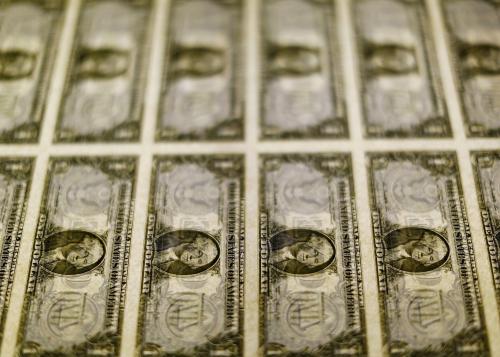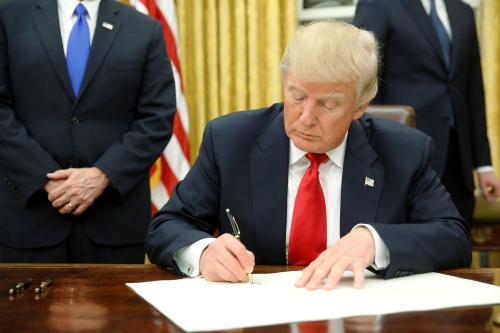This post originally appeared in Bloomberg.
It is not so easy to divine what Donald Trump’s victory means for financial regulation. His victory was in part driven by wave of anger and resentment over the financial crisis and its aftermath. Trump’s campaign narrative on what he would do “better” was inconsistent and contradictory, at one moment saying there’s too much regulation on banks and the next calling to reinstate Glass-Steagall — the Depression era legislation that has become shorthand for breaking up the banks and was a calling card for Senator Bernie Sander’s campaign. His transition team’s statement that they will “dismantle the Dodd-Frank Wall Street Reform and Consumer Protection Act of 2010 and replace it with new policies to encourage economic growth and job creation” does not give any indication of what he would propose instead.
Which path Trump takes will have profound ramifications for the future of finance and the American economy. It will also be a test of whether Trump takes advantage of his ultimate outsider status and charts his own course that defies typical partisan labeling, or whether he will simply help shepherd through the existing Congressional Republican legislative agenda on bank deregulation.
America’s reaction to the financial crisis created a series of strange political bedfellows. An unlikely alliance of people who are usually associated with the further edges of the political spectrum came together, in much the same way that a line can be tied together to form a circle by connecting the two outer edges. Such pairings include Sen. Rand Paul’s (R-KY) and Sen. Bernie Sanders (I-VT) to ‘Audit the Fed,’ Sen. Sherrod Brown (D-OH) and Sen. David Vitter (R-LA) to ‘End Too-Big-To-Fail,’ and Senators Elizabeth Warren (D-MA) and John McCain (R-AZ) to bring back Glass Steagall. None of these proposals became law. They are, to a large degree, contrary to the direction taken by Dodd-Frank. Like nationalizing or breaking up the big banks, they represent multiple paths not taken in response to the financial crisis.
Candidate Trump expressed support for several of these ideas, such as Audit the Fed and Glass Steagall. Both would be major changes to how the rules governing finance and the economy are currently structured. He went so far as to insert the call for Glass-Steagall into the official Republican Party platform, although some dismissed the importance of that as more of a political ploy for supporters of Senator Sanders. If he were to embrace any of these directions as President, he might find some levels of bipartisan support, but also plenty bipartisan resistance, including from parts of the financial services industry that supported his opponent, Hillary Clinton. Breaking up the big banks would be a radical change from current policy, be met with populist support, but also mean that millions of American consumers and many businesses might have to change banks, insurance companies, and the way they handle their own finances. Politically it would capture much of the populist momentum that Senators Sanders and Warren have championed.
The other direction is straightforward: deregulation. There are a litany of proposals to weaken the regulatory structure put in place under Dodd-Frank, from Senator Ted Cruz’s (R-TX) bill to eliminate the Consumer Financial Protection Bureau (CFPB) to just reducing its independence from Congress, to repealing the ability to resolve a failing systemic financial institution, and more. Most of these proposals have passed the Republican House of Representatives, usually on straight, or highly partisan, lines.
Candidate Trump expressed support for eliminating regulations he claimed are holding banks back from lending, although he never gave specific details as to which regulations he was referencing. With Republicans in full control of Congress, it would be possible for some of this agenda to be enacted, either with the support of a handful of moderate Democrats in the Senate, or through the more technical process of reconciliation through the budget, as several of these ideas have budgetary impacts. However, they would clearly incite the ire of financial reform advocates such as Senator Warren, and would be more of politics as usual in Washington. And while the stock market has initially cheered Trump’s election, with bank stocks in particular benefiting from the potential of a deregulatory feeding frenzy, people would be wise to recall what happened to banks by the end of Bush 43 Administration with the 2008 financial crisis.
The most comprehensive Republican alternative to Dodd-Frank is House Financial Services Chairman Jeb Hensarling’s (R-TX), Financial Choice Act. It cleared his committee with only Republican support at the end of this Congress. A radical departure from current bank regulation, the Choice Act would repudiate the structure put in place under Dodd-Frank, repealing many provisions such as the Volcker Rule’s restrictions on proprietary trading, the Durbin Amendment’s reduction in debit card interchange fees, and the government’s ability to wind down a failing systemically risky financial institution such as AIG.
The key question is which path President Trump will follow. Will he continue to defy simple political categorization and embrace some of the ideas that have bipartisan appeal but resistance from the middle, or will he be a more traditional deregulatory Republican? Will he be successful in whichever approach he takes? The answer to these questions may well determine if we can improve our economy in a sustainable manner, or if we are headed back on a path to another financial crisis.







Commentary
Op-edThe future of financial reform under President Trump
November 15, 2016